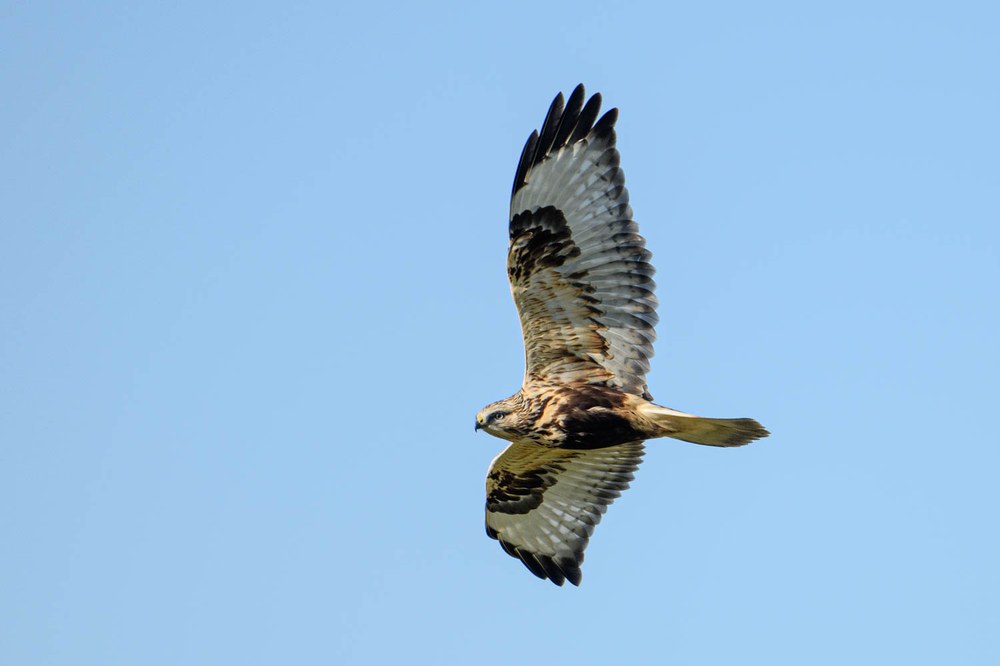
It was 4pm, and soon the light would fade - time was running out. The eleven participants on my Mountaineers trip seemed happy, but at least a dozen times someone had asked, “Are you going to find us a Rough-legged Hawk?” I was eager to ensure my students a happy trip, and hoped to catch a glimpse of this magnificent bird myself.
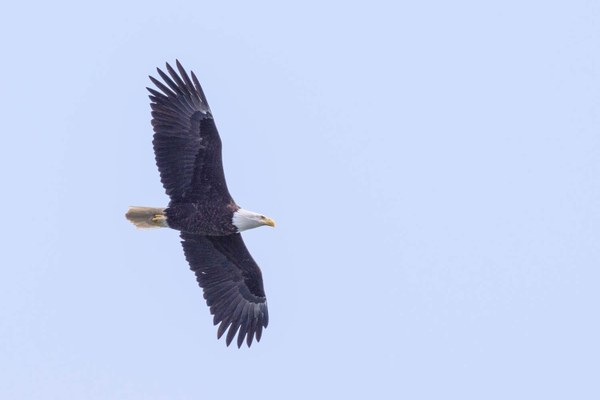 A Bald Eagle soars over the Stillaguamish on fixed wings using the slit updrafts. All photos by thomas bancroft.
A Bald Eagle soars over the Stillaguamish on fixed wings using the slit updrafts. All photos by thomas bancroft.
Our day had started along the Stillaguamish. Numerous Bald Eagles nest near the river and stay all year. Several Red-tailed Hawks were perched high in trees, scanning the surrounding fields for rodents. There, our best raptor was an adult Cooper's Hawk that sat on a tree near the road, watching a flock of starlings. It was alert, hunting, and zipped after those birds like a guided missile. Then, at Wylie Slough and Hayton Reserve on Fir Island, Bald Eagles, Red-tailed Hawks, and Northern Harriers blessed us with numerous sightings.
Our most exciting encounter, though, came when a massive flock of Dunlins flew over the restored mudflats at Hayton. Maybe five thousand of these shorebirds were performing, flying in unison. When all their backs pointed at us, the mass was dark. Then in synchrony, they flipped, showing their belly and underwings in a flash of white. They continued their dance, flipping up and then back. It was a distraction behavior to confuse attacking falcons. “Scan for a Peregrine or a Merlin,” I yelled. Behind us came a beautiful Peregrine Falcon, flying quickly on its long, pointed wings. It wasn't hunting, though, and continued without a glance at the frightened Dunlins.
 A Peregrin Falcon uses rapid wingbeats to zip along.
A Peregrin Falcon uses rapid wingbeats to zip along.
Before we left Fir Island, a female Kestrel stalked prey from the wires before the stop sign on Maupin Road. This little falcon dashed out and hovered above the field, then came back to a different place to continue her search. At the wildlife area along Rawlins Road I’d found Rough-legged Hawks in the past, but no luck on this trip. Harriers did give us a good show, though. Several flew low over the marshes and farm fields, quartering back and forth just feet above the grasses. Their flight seemed effortless as they teeter back and forth on fixed wings. Their faces look very similar to owls, and they use their hearing to detect small prey. Then, our caravan scurried north to the Samish Flats by way of Bayview.
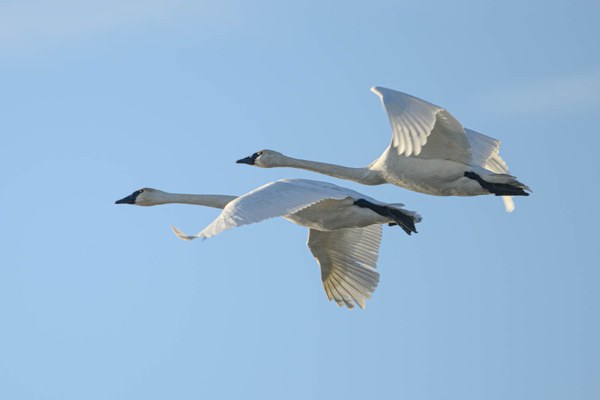 A pair of Trumpeter Swans circle our party on seven-foot wings.
A pair of Trumpeter Swans circle our party on seven-foot wings.
Numerous other bird species graced us that day. Elegant and gigantic Trumpeter Swans were everywhere, flying, sitting, feeding. This species is a conservation success. Its population had plummeted to only 69 known individuals in the late 1930s and now many thousands winter in western Washington alone. To watch a pair or family flying in unison is like watching a ballet; the grace and agility of these giants is breathtaking. Sparrows, chickadees, blackbirds, nuthatches, and woodpeckers flitted through trees, bushes, or fields. Although we missed seeing it on the ground, vast flocks of Snow Geese, more than several thousand, honked overhead. In the morning, numerous skeins flew out to feeding areas, and, in the afternoon, they came back to roosting places in the bay.
At Hayton Reserve, numerous white-looking birds were clustered in a distant field. Even before I put the scope on them, I knew from their profiles that they were decoys put out by hunters to attract Snow Geese. Still, I peered through the scope and motioned everyone to look as though it was a new sighting. Some decoys even had wings that twirled in the wind, adding to the illusion.
Eventually it was discovered that they were in fact decoys, not living Snow Geese. As we started toward the cars a mumble reached me: “Bancroft, you are devilish.” I chuckled. More than once in the past, distant decoys have caused me to stop and check. It’s humbling, and I couldn't resist sharing the experience with my class.
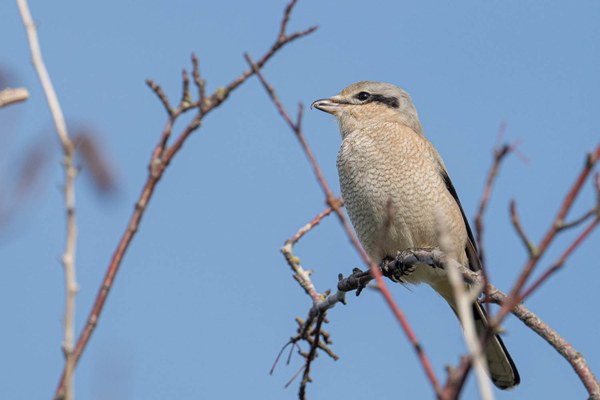 A first-winter Northern Shrike lands in a bush to survey the surrounding areas for possible prey items.
A first-winter Northern Shrike lands in a bush to survey the surrounding areas for possible prey items.
Maybe the best bird that day was a Northern Shrike. These are bold predators of small birds, mammals, and insects, even though the shrike is smaller than a robin. They lack strong feet like a hawk but have a robust bill. One flew into the thick bushes by the parking lot at Hayton Reserve, surveyed us, apparently decided we weren't edible and vanished. They are a bird of the far north and only come to Washington in large numbers during some winters.
Finding a Rough-legged Hawk, though, had been a priority. These birds are magnificent, big, powerful, and dynamically patterned. They nest on the Arctic tundra and only come to Washington for the winter, arriving in October or November and leaving in early spring. Every winter, they come south to the open agricultural areas of Western Washington. This species may be more common in eastern Washington's grassland and shrub-steppe, but a day trip there would be difficult, so I planned to include the Samish Flats on this trip.
Earlier, a large hawk had been perched on the wires a little way to the east of where we then stood. I had used the hand radio to tell people in the other two cars not to get out. It had the right shape and size for one. I pulled onto the opposite shoulder from the bird, and the other two parked behind me. A quick look through my binoculars, I thought, “Yes” and relayed that to the other two cars. At that point, the person in my passenger seat mumbled, “Ha, um, but,” and began to shift around in her seat. I looked over at her, a young woman, maybe in her twenties. She’d picked up the bird book but was looking forward, then across in front of me at the bird. “What?” I asked. She delayed some more before saying, "I thought you said in class that they should have feathers on their legs?”
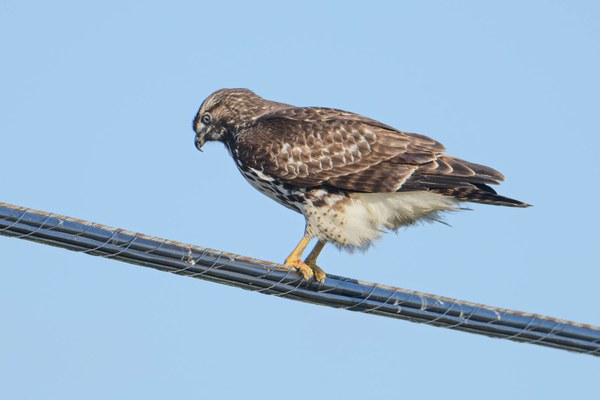 A red-tailed Hawk hunts from the wires in the Samish.
A red-tailed Hawk hunts from the wires in the Samish.
I snapped around - binoculars up in a second. The legs were bright yellow, with no feathers covering them. The chest, too, a mottled color, and the tail had light stripping. It was a perfectly plumaged juvenile Red-tailed Hawk. They lack the red tail at that age. I turned to my colleague, “You’re right, I blew it; it is a young red-tail.” She smiled and looked away. Rough-legged Hawks get their name from the feathers that run down their legs to their feet. They aren’t rough looking at all but rather soft like a fluffy blouse or lose sweatpants. My passenger relaxed as I picked up the radio, “Sorry, it is a red-tail, slowly open your doors and don’t slam them shut, it might stay.”
We continued our trip, admiring the landscape and the incredible creatures that belong to it. Then suddenly, a chance to redeem myself appeared.
“Look!” someone hollered, pointing to the sky. I whipped around, binoculars ready. A long way across the field was a big bird, hanging in the air, maybe a hundred feet above the grass. A Rough-legged Hawk for sure. No wind on this November day; the silhouette said it had to be a Buteo, and the Rough-leg is the only member of that genus here in the winter that can hover without a strong breeze. I grabbed my spotting scope and began madly focusing in on the distant raptor.
The bird hung in my spotting scope. The dark wrists, dark belly band, and light flight feathers identified it as an adult-plumaged light-phase female. Unfortunately, only half my participants got to look through the scope before she flew east.
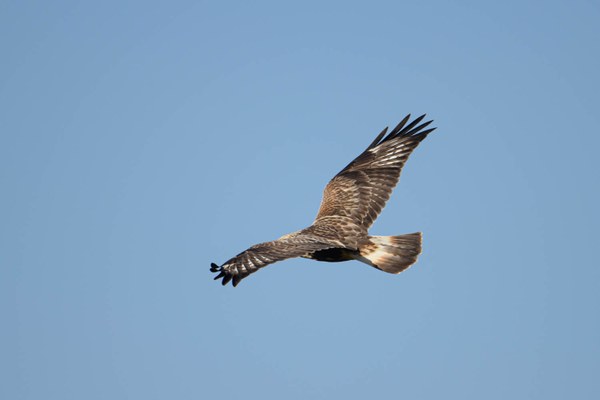 The Rough-legged Hawk does a slow circle over the fields, hunting for voles or mice.
The Rough-legged Hawk does a slow circle over the fields, hunting for voles or mice.
We leaped into the cars and bolted down the road toward Edison, chasing the bird, stopping at the left-hand bend. Luck greeted us. The Rough-legged was working the wet prairies, flying back and forth a dozen feet above the ground, occasionally hovering when she thought she'd detected movement, then continuing. She did drop once to the ground but came back up quickly, not having captured a mouse or vole. The smiles on people’s faces helped me relax. She brought us up to sighting seven raptor species so far.
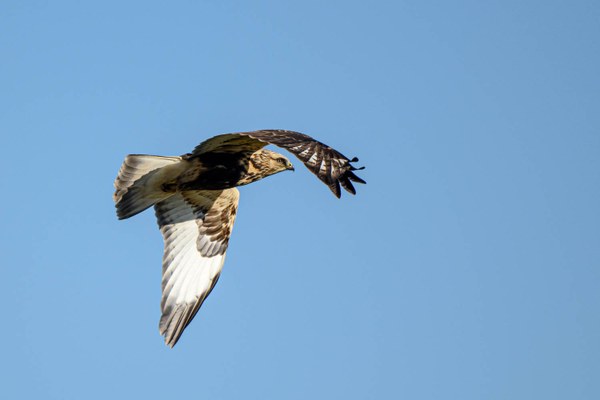 The Rough-legged Hawk begins to move off to another hunting area.
The Rough-legged Hawk begins to move off to another hunting area.
The Rough-legged Hawk was also our sixty-first bird species that day. After so much activity, it was getting late. “Has everyone had a good look at the Rough-leg?” I turned to see if everyone was on board, “I have one more stop if people are up for it.” The nods confirmed. I generally don’t tell people what we might find at a specific place for fear that we don’t, and they become disappointed or even upset. But sometimes it's best to keep everyone on alert. “I want to walk around Edison. A pair of Merlins lives there, and although I've never seen them, they are found regularly by birders. Scan the tops of the trees and keep a lookout for a fast-flying small falcon. If we find one, it is likely to be a quick look,” I said, as we climbed back into the cars.
Edison is most famous for its bakery, small restaurants, and art galleries. Other than the main drag, the streets are quiet. At one point, a young Bald Eagle flew right over our heads. It seemed like we could have touched it. Something hung from its talons, and another eagle was in hot pursuit. The second turned upside down and tried to grab the item, unsuccessfully. It was exciting, but no Merlin made its appearance. I've still never seen a Merlin in that town, but several people I've taken there have found this marvelous falcon later. One just never knows with birds; it’s part of the fun.
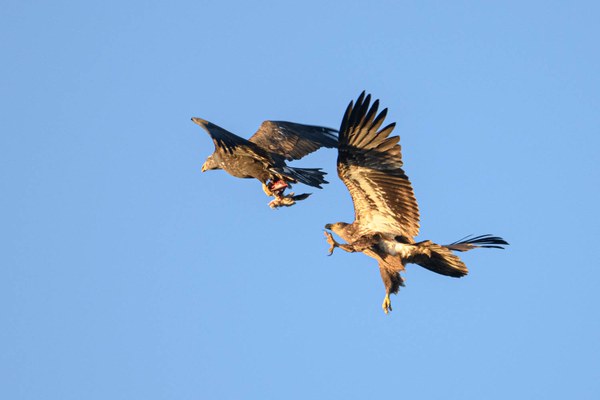 One Bald Eagle tries to steal a prey item from another. These birds were just hatched the previous spring.
One Bald Eagle tries to steal a prey item from another. These birds were just hatched the previous spring.
Raptor Identification Course October 2020
Join us for our upcoming raptor identification course, Soaring Past COVID: Hawks, Eagles, and Falcons of Washington. This course will cover all 20 species found regularly in Washington, including how to identify them, their habitats, behaviors, and distribution. Possible itineraries for self-guided trips to find these magnificent birds will be discussed.
This course will be taught by Thomas Bancroft and Danielle Graham, both experienced Mountaineers leaders and volunteers. Bancroft is a professional ornithologist and conservationist and Graham is trained as a natural resource planner, as well as a trip leader for naturalists, hiking, snowshoeing, Nordic skiing, stewardship, and climbing.
Add a comment
Log in to add comments.What a fabulous write up on a terrific trip. So exciting to be able to see all these birds. You must be stoked! Thanks for sharing.
 Thomas Bancroft
Thomas Bancroft